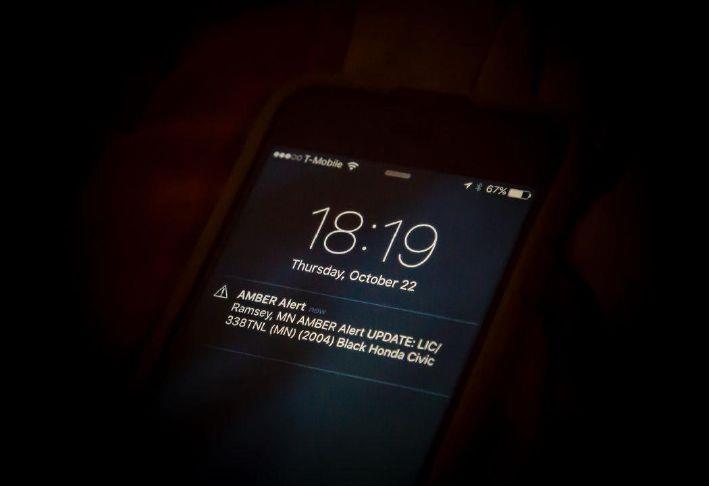According to the Texas Center for the Missing, there were 48,008 missing persons reports with 35,181 of those children in Texas in 2023. For children, the Center notes 80-85% of those are believed to be runaways, 10-15% are believed to be family abductions, 3-4% are believed to be non-family abductions and less than 1% are believed to be stranger abductions.
“Despite the odds, the vast majority of missing persons are recovered through collaboration and dedication,” TCM information says.
One of the most public forms of local, county, state and beyond collaborations is through the alert system. There are six types of alerts and each targets a different type of individual and situation.
Sherman Police Department Public Information Officer Sgt. Brandon Hughes said there is no set limit of time that any agency has to wait before it can take a missing persons complaint.
“However, each law enforcement agency may have some different parameters in regard to their investigative procedures for missing persons,” he said.
Hughes also said it is important to know what kind of information law enforcement will need to determine if a particular alert can be issued and information the public can use to determine if the alerts they see on social media and other places are real.
“Based on the criteria of the alerts, the biggest thing people need is documentation of their loved ones’ medical condition (Required for Silver Alert, Endangered Missing Persons Alert, etc.),” he said.
Only a law enforcement agency or authorized entity can make a request to activate the State Network, and the entities that collaborate to disseminate information related to alerts are the Texas Department of Transportation, National Weather Service (for Amber Alerts only), law enforcement, media, the Texas Lottery Commission, Independent Bankers Association of Texas, National Center for Missing and Exploited Children (for Amber Alerts only) and Texas Department of Public Safety.
Hughes said there are ways the general public can ensure alerts that are circulated are real. He said they should start by considering the source.
“Who is spreading this information?” he asked. “Is it a known or trusted person/entity/business? Peruse the profile of the person/entity/business posting the information. Is the account credible? Has it been active for a while?”
Then, compare the information to other reliable or trusted sources.
“Have those reliable/trusted sources verified the information?” he continued.
People should think critically.
“Does the post/message have spelling/grammar errors? Are other people speaking up about it being a scam?” Hughes asked.
“If you ever have any questions about the legitimacy of a post/message, call that entity/business directly or call your local police department. They should be able to provide some verification about the validity of a post/message.”
Once an alert is determined to be real, what can people do to help find the missing person?
“Just be observant,” Hughes said. “If they happen to see the person or vehicle for the ALERT they saw, report that information to law enforcement.”
Silver Alert
The Silver Alert, a Texas program was created in 2007, designed to notify the public of missing older adults with a documented mental condition.
In order for a Silver Alert to be issued, the missing person must be 65 years or older, have been diagnosed with Alzheimer’s or have impaired mental condition their disappearance poses a credible threat to the senior citizen’s health and safety.
Law enforcement shall require the family or legal guardian of the missing senior citizen to provide documentation from a medical or mental health professional of the person’s condition.
Also, an investigation must verify the missing person’s disappearance is due to their impaired mental condition and alternative reasons for their disappearance must be ruled out
The Silver Alert request has to be made within 72 hours of the disappearance, and there must be sufficient information available to disseminate to the public that could assist in locating the senior citizen.
Amber Alert
The Amber Alert was created in 2002 to inform the public of serious child abductions.
For these types of alerts, missing persons must be 17 years of age or younger, their whereabouts are unknown, and disappearance must be determined to be unwilling, and pose a credible threat to the child’s safety. If the individual’s abduction was by a parent or legal guardian, the abduction must have been in the course of murder or attempted murder.
Or, the missing person must be a child 13 years of age or younger, who was taken willingly or not, without permission from a parent or legal guardian, someone unrelated and more than three years older, or another parent or legal guardian who attempted or committed murder at the time of the abduction.
Additional criteria include if the child is in immediate danger of sexual assault, death or serious bodily injury, has a preliminary investigation verifying the abduction and eliminating alternative explanations for the child’s disappearance, and there is sufficient information available to disseminate to the public to help locate the child, a suspect or the vehicle used in the abduction.
Blue Alert
The third alert that Hughes discussed was the Blue Alert which was created in 2008 and designed to speed up the apprehension of violent criminals who have killed or seriously wound law enforcement officers.
To trigger this alert, a law enforcement officer has been killed or seriously injured by an offender, the investigating law enforcement agency must determine that the offender poses a serious risk or threat to the public and other law enforcement personnel, a detailed description of the offender’s vehicle, vehicle tag or partial tag must be available for broadcast to the public and the investigating law enforcement agency of jurisdiction must recommend activation of the Blue Alert to the Texas Department of Public Safety (DPS).
Clear Alert
The Clear Alert was created in 2019 and designed to assist law enforcement in locating and rescuing missing, kidnapped, or abducted adults who are in immediate danger of injury death, as well as aid in locating potential suspects.
For this alert, the individual must be between 18-64 years old and their whereabouts are unknown. It must also include a preliminary investigation verifying the adult is in imminent danger or bodily injury or death or that the disappearance is involuntary, such as an abduction or kidnapping.
The Clear Alert must be requested within 72 hours of the individual’s disappearance, and there has to be sufficient information available to disseminate to the public to help locate the individual, a suspect or the vehicle used in the incident.
Endangered Missing Persons Alert
One of the alerts that North Texans see frequently is the Endangered Missing Persons Alert which was created in 2011 and is designed to include alerts for missing persons (any age) with an intellectual disability (autism, development disorder, etc.).
Hughes said for this alert, the missing person must have been diagnosed with an intellectual disability and/or a pervasive development disorder and law enforcement requires a written diagnosis from a physician or psychologist licensed to practice within Texas or certified by Texas Aging/Disability or State Health Services.
There must be a confirmed investigation verifying that a reasonable explanation for the missing person’s disappearance has been ruled out and that the disappearance poses a credible threat to the health/safety of the missing person. The request must be made within 72 hours of the missing person’s disappearance, and there must be sufficient information available to disseminate to the public that it could assist in locating the missing person.
Active Shooter Alert
The final alert that Hughes discussed is one everyone hopes they never receive.
The Active Shooter Alert was created in 2021 and designed to alert individuals in close proximity of active shooter situations through their cell phone devices, local media, Department of Transportation signs, and other resources.
“An active shooter is defined by the FBI as an individual actively engaged in killing or attempting to kill people in a populated area,” Hughes said.
This alert is used if an active shooter is in the requesting agency’s jurisdiction, it has been determination that an Active Shooter Alert would assist individuals near the active shooter’s location, verification exists of the active shooter situation through a preliminary investigation by the requesting agency and the active shooter’s last known location is identifiable.




